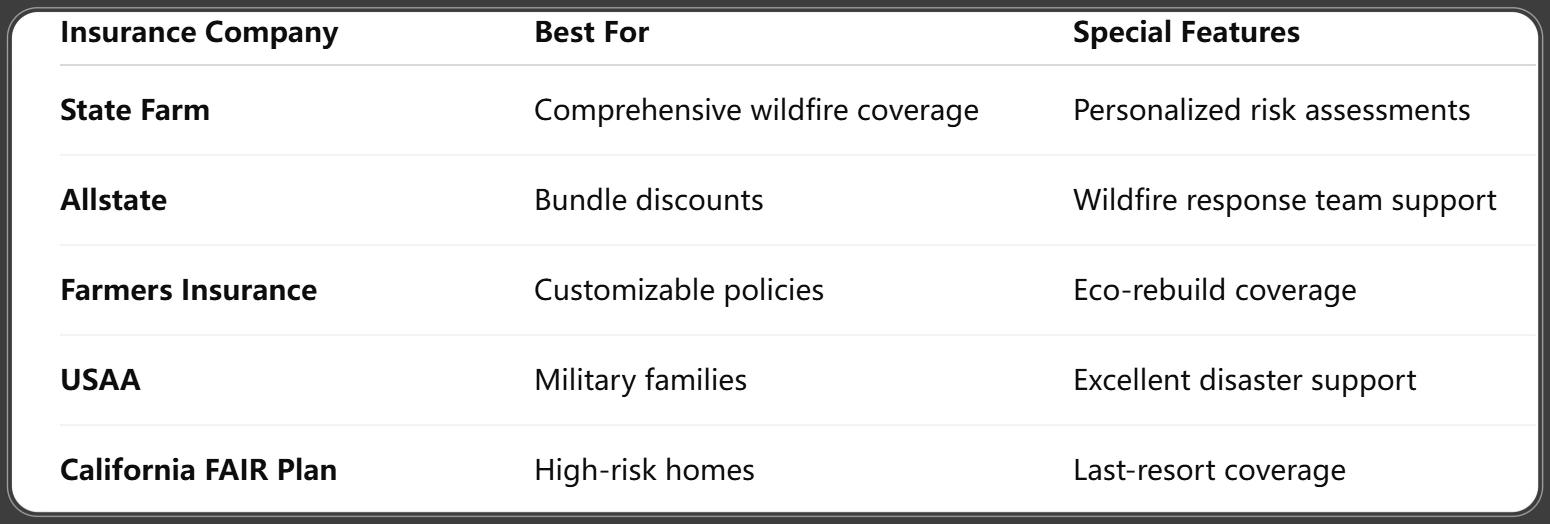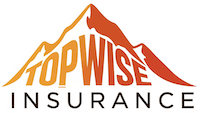Best Home Insurance for Wildfire Areas 2025 – Top Picks, Rates & FAQs
Published on August 7, 2025

Sarah Patel
Homeowners & Property Insurance Expert.
Sarah Patel is a property underwriter-turned-writer with 10 years in the field; she focuses on flood, wildfire, and replacement-cost planning for homeowners.
Understanding the Wildfire Risk in 2025
In 2025, the risk of wildfires continues to grow, especially across the western United States. As climate change intensifies, dry seasons are lasting longer, temperatures are climbing, and vegetation is drying out faster—creating the perfect storm for devastating fires.
Climate Patterns and Wildfire Zones
Over the last decade, extreme heatwaves and prolonged droughts have reshaped the climate profile of many states. Regions such as California, Oregon, Washington, Arizona, and Colorado are now classified as high to extreme risk zones for wildfires.
Rising Frequency of Wildfires Across the U.S.
According to data from the National Interagency Fire Center (NIFC), wildfire incidents have surged by over 30% since 2010. In 2024 alone, more than 10 million acres burned—damaging thousands of homes and displacing countless families.
High-Risk States in 2025
States facing the highest wildfire threat include:
- California
- Texas
- Colorado
- Arizona
- Nevada
- Oregon
- Idaho
Homeowners in these areas must secure wildfire-specific home insurance coverage to mitigate potential losses.
Why Home Insurance Is Crucial in Wildfire Zones
Financial Impact of Wildfire Damage
Wildfires can cause hundreds of thousands of dollars in damage. Rebuilding a home, replacing personal belongings, and finding temporary shelter can place a massive financial burden on families. Without insurance, these costs fall solely on the homeowner.
Role of Home Insurance in Disaster Recovery
Home insurance acts as a safety net. It not only pays for repairs and rebuilding but also covers personal property, relocation expenses, and even liability if someone is injured on your property due to the disaster. In high-risk zones, having proper coverage can make the difference between recovery and financial ruin.
What Is Covered in Home Insurance for Wildfire Areas?
Standard Policy Coverage
Most standard homeowners insurance policies cover fire damage, including wildfires. This typically includes:
- Dwelling coverage: Rebuilds or repairs the home structure.
- Personal property coverage: Replaces personal belongings like furniture, clothes, and electronics.
- Loss of use: Pays for temporary housing and living expenses.
- Liability coverage: Covers legal expenses if someone is injured on your property.
Wildfire-Specific Add-ons and Endorsements
Insurers now offer wildfire endorsements that enhance protection. These may include:
- Debris removal
- Landscape restoration
- Extended dwelling coverage
- Building code upgrades
What’s Not Covered: Common Exclusions in Wildfire Policies
Negligence and Lack of Maintenance
Insurers may deny claims if they believe the homeowner failed to maintain the property or ignored fire prevention recommendations (e.g., removing dead vegetation).
Limits on High-Value Items
Jewelry, fine art, and collectibles often have sub-limits in standard policies. You’ll need scheduled personal property endorsements for full protection.
Temporary Housing and Alternate Accommodations
While most policies cover temporary housing, there may be daily or total payout limits, so it's important to know exactly what your policy provides.
2025 Updates to Home Insurance in High-Risk Zones
Regulatory Changes and State Mandates
States like California and Oregon have introduced new laws requiring insurers to provide transparency around wildfire risk scoring and coverage decisions. Some areas now mandate minimum fire-prevention efforts to qualify for home insurance.
Insurer Response to Climate Data
Many insurers have adjusted their models, relying on AI and satellite technology to assess fire risk. Some have stopped issuing new policies in the most extreme zones, while others have raised premiums significantly.
New Policy Limitations or Rate Hikes
Due to increased losses, insurers in 2025 are:
- Increasing wildfire deductibles
- Offering limited policies in certain zip codes
- Requiring property inspections for renewals
How Insurance Companies Assess Wildfire Risk in 2025
FireLine® Score and Satellite Mapping
Tools like FireLine® provide a risk score based on topography, vegetation, and access to emergency services. Homes with a high score may face higher premiums or policy denial.
Proximity to Fire Stations and Water Sources
Being within 5 miles of a fire department or having access to hydrants can reduce your risk score and premium.
Landscaping and Defensible Space
Properties that maintain defensible space—cleared land around the home to slow fires—are favored by insurers. Some may even require it for policy issuance.
Top Home Insurance Providers for Wildfire Areas in 2025

Comparing Rates: What You Can Expect to Pay in 2025
Premium Ranges in Wildfire-Prone Regions
Home insurance premiums in high-risk wildfire zones range from $2,500 to $7,500 per year—sometimes even higher depending on location and coverage.
Deductible Considerations
Some policies now feature wildfire-specific deductibles, often higher than standard ones (e.g., 5-10% of dwelling coverage).
Discounts and Savings Programs
- Wildfire mitigation discounts
- Home security systems
- Multi-policy (auto + home) bundles
How to Lower Your Wildfire Insurance Premium
Home Hardening Techniques
- Install dual-pane, tempered glass windows
- Enclose eaves and vents
- Use non-combustible siding
Installing Fire-Resistant Roofing and Materials
Metal, tile, and asphalt fiberglass shingles offer better fire resistance than wood.
Joining Firewise USA® Communities
Homeowners in Firewise-recognized communities often receive discounts and better coverage options.
Government Programs and Wildfire Insurance Assistance
FAIR Plans
These are state-backed plans for homes denied coverage in the traditional market.
California’s Wildfire Fund
Supports insurers and homeowners with reinsurance and rebuilding costs.
FEMA Disaster Relief
While FEMA doesn’t replace insurance, it provides limited emergency aid after declared disasters.
Special Considerations for Second Homes and Cabins in Wildfire Zones
Vacation Rental Insurance Gaps
If your second home is used as a short-term rental (e.g., Airbnb, Vrbo), standard homeowners insurance may not cover damage during guest stays. In wildfire-prone areas, you’ll need specialty vacation rental insurance that includes fire and liability protection for guests.
Long-Term Unoccupied Home Risks
Insurers often deny claims if a home is left unoccupied for more than 30-60 days without proper notification. For wildfire areas, the risk of unnoticed fires is higher. You may need a vacant home endorsement or a separate policy that keeps coverage intact while the property is vacant.
Filing a Wildfire Damage Claim: Step-by-Step Guide
Documentation and Photo Evidence
Before wildfire season starts:
- Photograph every room and item in your home
- Save digital receipts for valuables
- Store these files on a cloud service for safety
After a wildfire:
- Take photos of all damage
- Make a list of lost or damaged items
- Don’t throw anything away until your adjuster sees it
Contacting Adjusters
- Call your insurer immediately after the fire is contained
- Request a claim number and adjuster assignment
- Follow up regularly—delays can cost you money
Claim Denial Appeals
If your claim is denied or underpaid:
- Review the denial letter carefully
- Hire a public adjuster if needed
- File a formal appeal or contact your state’s insurance commissioner
Wildfire Preparedness and Prevention Tips
Being proactive can reduce your insurance costs and protect your property.
Emergency Evacuation Plans
- Have a “go bag” ready with documents, medications, and essentials
- Set evacuation routes and meeting points
- Sign up for local fire alert systems
Fire-Resistant Landscaping
- Keep grass trimmed and trees pruned
- Use gravel, stone, or fire-resistant plants
- Maintain a 30-foot defensible space around your home
Home Inventory Checklist
Keep an updated inventory of:
- Furniture and appliances
- Jewelry and electronics
- Important documents (deeds, passports, insurance policies)
Use apps like Encircle or Sortly for digital tracking.
Common Mistakes to Avoid with Wildfire Home Insurance
Underinsuring Your Home
Many homeowners only insure their homes for market value. But rebuilding costs can be higher, especially after disasters when materials and labor prices spike.
Overlooking Exclusions
Policies may exclude damage from smoke, ash, or heat unless specifically added. Always read the fine print and ask your agent for clarification.
Skipping Annual Policy Reviews
Your home value, inventory, and local fire risk change each year. Reviewing your policy annually ensures your coverage remains accurate and sufficient.
Frequently Asked Questions About Home Insurance for Wildfire Areas
1. Can I get coverage if I live in a high-risk zone?
Yes, but options may be limited. Many insurers still offer policies, though state-backed FAIR Plans might be your last resort in extreme zones.
2. Will my policy cover rebuilding costs?
Only if your policy includes replacement cost coverage. Otherwise, you’ll get only the depreciated value. Always confirm you have extended or guaranteed replacement coverage.
3. What happens if my insurer drops me?
You can:
- Apply for coverage with a new insurer
- Join your state’s FAIR Plan
- File a complaint with your state’s Department of Insurance
4. Can I combine wildfire insurance with other disaster policies?
Yes. You can bundle it with flood insurance, earthquake insurance, and umbrella liability policies to create a well-rounded disaster protection plan.
5. How often should I update my home inventory?
At least once a year, or whenever you make big purchases or home upgrades.
6. Does renters insurance cover wildfires?
Yes, if the wildfire damages your belongings. But it won’t cover structural damage—that’s the landlord’s responsibility.
Conclusion: Protecting Your Home and Future in Wildfire Zones
Living in a wildfire-prone area doesn’t mean you’re helpless. By choosing the right home insurance for wildfire areas 2025, you can safeguard your home, finances, and peace of mind. From selecting a reliable insurer to implementing fire prevention measures, the key lies in preparation and awareness.
As wildfire seasons grow longer and more intense, homeowners must adapt. The right policy is not just protection—it’s a critical step toward recovery. Don’t wait for the next red flag warning to act.
You Might Also Like
Home Insurance for Mobile Homes 2025: 10 Expert Tips for Affordable & Reliable Coverage
Aug 8, 2025Home Insurance for New Construction 2025: Essential Guide with Expert Tips & Cost Insights
Aug 8, 2025Best & Affordable Home Insurance for Vacant Homes 2025
Aug 7, 2025Best Guide to Home Insurance for Solar Panels 2025: Protect Your Investment Smartly
Aug 7, 2025Top-Rated Home Insurance for Historic Homes 2025: Expert Tips & Must-Know Facts
Aug 7, 2025
